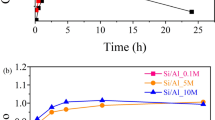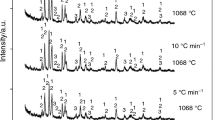Abstract
Liquidus temperatures (TL) were measured, and primary phases were determined for 50 (from an initial test matrix of 76) compositions within the Al2O3–B2O3–CaO–Na2O–SiO2 glass-forming system and its constituent ternary subsystems. Strong linear correlations have been found between composition and TL for melts within the same primary phase fields. The TL and primary phase data are being used to develop and refine a modified associate species model (ASM). The impacts of Fe2O3, Li2O, NiO, ZrO2, Cr2O3, ZnO, and MnO additions on the TL of two baseline glass compositions are reported. These data are intended as benchmarks for further expansion of the ASM or other silicate melt solution models of nuclear waste glasses.
Similar content being viewed by others
References
Design Construction and Commissioning of the Hanford Tank Waste Treatment and Immobilization Plant. U.S. Department of Energy Contract No. DE-AC27-01RV14136 (2000 as amended).
D.S. Kim and P. Hrma: Models for liquidus temperature of nuclear waste glasses. Ceram. Trans. 45 327 (1994).
I.G. Choi D.F. Bickford and J.T. Carter: Thermal effects of electrically conductive deposits in a joule-heated melter. Ceram. Trans. 29 645 (1993).
D.S. Kim and J.D. Vienna: Influence of glass property restrictions on Hanford HLW glass volume. Ceram. Trans. 132 105 (2002).
P. Hrma J.D. Vienna and M.J. Schweiger: Liquidus temperature limited waste loading maximization for vitrified HLW. Ceram. Trans. 72 449 (1996).
T.M. Besmann and K.E. Spear: Thermochemical modeling of oxide glasses. J. Am. Ceram. Soc. 85 2887 (2002).
T.M. Besmann K.E. Spear and J.D. Vienna: Extension of the modified associate species thermochemical model for high-level nuclear waste: Inclusion of chromia in Scientific Basis for Nuclear Waste Management XXVI edited by R.J. Finch and D.B. Bullen (Mater. Res. Soc. Symp. Proc. 757 Warrendale PA 2003) p. 195.
T.M. Besmann N.S. Kulkarni and K.E. Spear: Thermochemical and phase equilibria property prediction for oxide glass systems based on the modified associate species approach in High Temperature Corrosion and Materials Technology IV edited by E. Opila P. Hou T. Maruyama B. Pieraggi M. McNallan D. Shifler and E. Wuchina. (The Electrochemical Society Pennington NJ 2004) p. 557.
K.E. Spear T.M. Besmann and E.E. Beahm: Thermochemical modeling of glass: Application to high-level nuclear waste glass. MRS Bull. 24(4) 37 (1999).
J.V. Crum P. Hrma M.J. Schweiger and G.F. Piepel: Liquidus temperature models for high-level waste glasses that precipitate zirconium-containing crystalline phases. Ceram. Trans. 87 271 (1998).
T. Plaisted P. Hrma J. Vienna and A. Jiricka: Liquidus temperature and primary phase in high-zirconia high-level waste borosilicate glasses in Scientific Basis for Nucelar Waste Management XXIII edited by R.W. Smith and D.W. Shoesmith (Mater. Res. Soc. Symp. Proc. 608 Warrendale PA 2000) p. 709.
J.D. Vienna P. Hrma J.V. Crum and M. Mika: Liquidus temperature-composition model for multi-component glasses in the Fe Cr Ni and Mn spinel primary phase field. J. Non-Cryst. Solids 292 1 (2001).
P. Hrma J. Vienna J. Crum and G. Piepel: Liquidus temperature of high-level waste borosilicate glasses with spinel primary phase in Scientific Basis for Nucelar Waste Management XXIII edited by R.W. Smith and D.W. Shoesmith (Mater. Res. Soc. Symp. Proc. 608 Warrendale PA 2000) p. 671.
M. Mika M.J. Schweiger J.D. Vienna and P. Hrma: Liquidus temperature of spinel precipitating high-level waste glasses in Scientific Basis for Nucelar Waste Management XX edited by W.J. Gray and I.R. Tridy (Mater. Res. Soc. Symp. Proc. 465 Pittsburgh PA 1997) p. 71.
J.D. Vienna: Nuclear waste glasses in Properties of Glass-Forming Melts edited by L.D. Pye I. Joseph and A. Montenero (CRC Press Boca Raton FL 2005). pp. 391–403.
J.W. Hastie and D.W. Bonnell: A predictive phase-equilibrium model for multicomponent oxide mixtures. 2. Oxides of Na–K–Ca–Mg–Al–Si. High Temp. Sci. 19 275 (1985).
D.W. Bonnell and J.W. Hastie: A predictive thermodynamic model for complex high-temperature solution phases 11. High Temp. Sci. 26 313 (1989).
B.A. Shakhmatkin N.M. Vedishcheva and A.C. Wright: Can thermodynamics relate the properties of melts and glasses to their structure? J. Non-Cryst. Solids 293 220 (2001).
B.A. Shakhmatkin N.M. Vedishcheva M.M. Shultz and A.C. Wright: The thermodynamic properties of oxide glasses and glass-forming liquids and their chemical-structure. J. Non-Cryst. Solids 177 249 (1994).
E.F. Osborn and A. Muan: Fig. 501 in Phase Diagrams for Ceramists Vol. 1 edited by E.M. Levin C.R. Robbins and H.F. McMurdie (The American Ceramic Society Columbus OH 1964) p. 181.
G.W. Morey and N.L. Bowen: J. Soc. Glass Technol. 9 p. 232 (1925) reprinted as Fig. 482 in Phase Diagrams for Ceramists Vol. 1 edited by E.M. Levin C.R. Robbins and H.F. McMurdie (The American Ceramic Society Columbus OH 1964) p. 175.
E.F. Osborn and A. Muan: Fig. 630 in Phase Diagrams for Ceramists Vol. 1 edited by E.M. Levin C.R. Robbins and H.F. McMurdie (The American Ceramic Society Columbus OH 1964) p. 219.
ASTM C829-81: Standard practices for measurement of liquidus temperature of glass by the gradient furnace method. (re-approved 1995) in 1999 Annual Book of ASTM Standards, Vol. 15.02 (American Society for Testing and Materials West Conshohocken PA 1999).
R. Backman K.H. Karlsson M. Cable and N.P. Pennington: Model for liquidus temperature of multi-component silicate glasses. Phys. Chem. Glasses 38 103 (1997).
C. Dreyfus and G. Dreyfus: A machine learning approach to the estimation of the liquidus temperature of glass-forming oxide blends. J. Non-Cryst. Solids 318 63 (2003).
H. Li B. Jones P. Hrma and J.D. Vienna: Compositional effects on liquidus temperature of Hanford simulated high-level waste glasses precipitating nepheline (NaAlSiO4). Ceram. Trans. 87 279 (1998).
ASTM E1508-98: Standard guide for quantitative analysis by energy-dispersive spectroscopy in 2003 Annual Book of ASTM Standards Vol. 03.01 (American Society for Testing and Materials West Conshohocken PA 2003).
E.B. Pretorius and A. Muan: Stability of CaNiSi2O6 (“niopside”) and activity-composition relations of CaMgSi2O6 solid solutions at 1350°C. J. Am. Ceram. Soc. 75 1458 (1992).
Author information
Authors and Affiliations
Corresponding author
Rights and permissions
About this article
Cite this article
Hanni, J.B., Pressly, E., Crum, J.V. et al. Liquidus temperature measurements for modeling oxide glass systems relevant to nuclear waste vitrification. Journal of Materials Research 20, 3346–3357 (2005). https://doi.org/10.1557/jmr.2005.0424
Received:
Accepted:
Published:
Issue Date:
DOI: https://doi.org/10.1557/jmr.2005.0424




